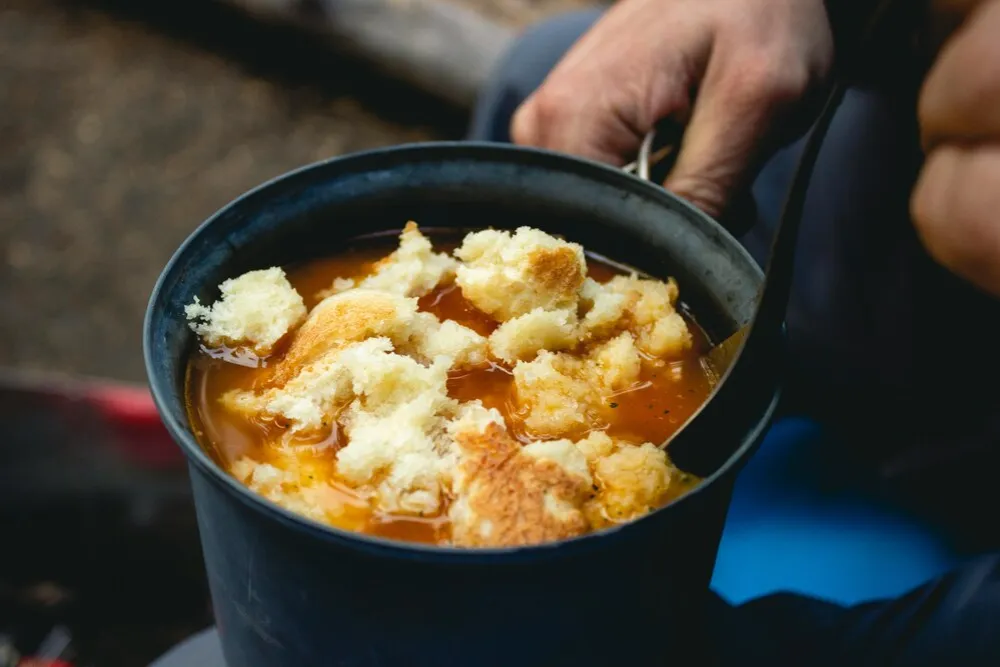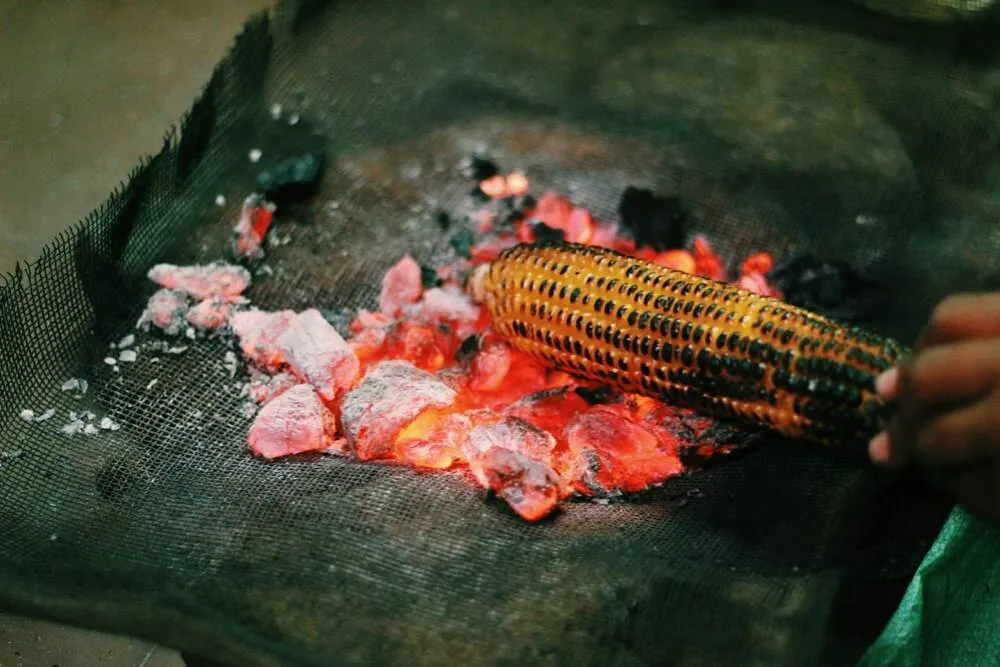Camp Cooking 101: Recipes and Techniques from the Great Outdoors
The campfire crackles, stars twinkle above, and your stomach rumbles with anticipation. Cooking in the wild isn’t just about eating – it’s about savoring the simple things after a day of adventure. Camp cooking 101 begins here!
Don’t worry if you are a beginner camper, delicious camp meals are within your reach. Your mornings will be filled with the smell of bacon frying in a skillet. Discover different ways to cook corn on the cob. Eat s’mores with the moon for company.
With a little planning, some simple recipes, and the right techniques, your wilderness kitchen will be the envy of the campground.
You don’t need fancy equipment or exotic ingredients. Go camping with confidence, knowing you’ll have some decent grub!
Keep prep simple: home and in camp
- Balance Nutrition and Weight: Outdoor adventures demand energy. Fuel your body with nutritious foods, but when hiking or backpacking, every ounce matters. Dried fruits and veggies weigh less than fresh ones, while still providing important vitamins. Opt for sources of protein like jerky, canned tuna or salmon, or dehydrated beans and lentils.
- Smart Food Choices: Instant noodles, couscous, and pre-cooked pasta are trail favorites because they cook quickly, saving fuel. But don’t forget the flavor! Throw in dried vegetables, spices, and a bit of mock meat to elevate these simple dishes.
- The Menu Matters: Decide what you’ll eat each day in advance. This ensures you pack the right ingredients, avoids unnecessary weight, and helps you plan around food perishability (fresh items get eaten first!)
- Gear Up: A Swiss Army knife is any camper’s best friend. Include lightweight cutlery, plates, and bowls suitable for hot food. Invest in a camping stove (propane, butane, or white gas versions are common) and the right type of fuel. Collapsible cooking pots and pans are ideal for saving space. Consider a water purifier if you won’t have access to reliable clean water sources.

Easy Campfire Cooking 101: Forget the Cutting Board
Cooking while camping doesn’t need to be elaborate. Campfire meals can come from a packet. Here is a list of easy camping meals. You don’t need any fancy equipment, just a packet and water will go a long way.
- Noodle Know-How: Instant noodles are the ultimate trail staple. Sprinkle in a few ingredients to make these fun. You can increase flavor and nutrition by adding a handful of dried vegetables, a bit of protein powder or mock meat, and your favorite dried herbs or spice mixes. You can’t get much simpler than cowboy ramen.
- Couscous Creations: Couscous is another fast, filling grain. Pack small containers of spices like curry powder or Italian herb mixes. Toss in a can of chickpeas or black beans for protein and a satisfying meal.
- Tuna Pasta Power: Pre-cook the pasta before leaving home to save fuel. Toss it with tuna in oil, some dried veggies, and a flavorful sauce for a hassle-free dinner. This is an outdoor feast! I need the carbs for hiking.
- Pancake Perfection: Boxed pancake mix just needs water, making it an easy camp breakfast. Dried fruits like raisins or blueberries add sweetness, while nuts provide healthy fats.
- Oatmeal with Oomph: Hot oatmeal is a classic for a reason. Dried fruit and a sprinkle of cinnamon make it special. If you have powdered milk, adding it to the hot water creates a comforting, creamy porridge.
- Rice Cakes + Fixings: Rice cakes are a lightweight snack. Spread them with nut butter, mashed avocado, or canned fish for an energy boost.
Camp Cooking 101 Pro Tips
- Pack for Success: Use resealable bags for portioning ingredients, both to save space and keep things organized. Pack your spices in tiny containers or reusable straws to avoid bulky bottles.
- Cleanup Considerations: A small bottle of biodegradable soap, a sponge, and a quick-dry towel will make washing up much easier.
- Fuel Wisely: Research the best type of stove fuel for your trip’s needs. Learn how to estimate how much fuel your stove will consume to avoid running out.
- Safety First: Practice fire safety! If building a campfire, always use designated fire rings, clear a wide area, and never leave it unattended.
Campfire Cooking Techniques
Even without fancy gear, you can make amazing meals using your campfire. Here are the most popular methods:
- Boiling: A pot of water over the fire is your key to hot drinks, easy pasta dishes, and anything that comes pre-packaged. If using water from a natural source, boil it for at least one minute for safety.
- Grilling: Get that classic smoky flavor! A grill grate lets you cook burgers, steaks, veggies, and more. Prep ingredients at home to make campsite cooking a breeze. Grilling corn on the cob is a great way to enhance the flavor.
- Foil Packets: The easiest method – prep entire meals (meat, veggies, seasonings) in foil packets at home, then just toss them on the fire. Great for complete dinners or tasty side dishes.
- Cast Iron: This versatile workhorse heats evenly for everything from searing meat to baking goodies. It’s heavy, so better for car camping. Remember an oven mitt!
- On a Stick: The ultimate campfire tradition! Roast hotdogs, marshmallows, or experiment with bacon, fruit, or dough for yummy treats. Long skewers or specialized roasting sticks are ideal.
Campfire Tuna Noodle Casserole
You don’t need exotic ingredients to make Campfire Tuna Noodle Casserole! This is an easy recipe to make, you don’t need much cookware either. And it’s an easy clean up too!
Ingredients:
- 1 box instant macaroni and cheese (or similar noodles)
- 1 can tuna, drained
- 1/2 cup dried vegetables (peas, carrots, corn work well)
- 1/4 cup powdered milk
- Spices to taste (salt, pepper, garlic powder, etc.)
- Water
Equipment:
- Pot for cooking
- Campfire or stove
- Spoon for stirring
Instructions:
- Cook the noodles: Follow the package directions, boiling the noodles in water until tender. Drain well.
- Mix it up: Add the tuna, dried vegetables, powdered milk, and spices to the noodles. Stir well.
- Adjust and cook: Add enough water to create a slightly saucy consistency (start with a little and add more if needed). Heat over your campfire or stove, stirring frequently, until warmed through.
- Enjoy! Serve immediately for a satisfying and comforting camp meal.
Variations:
- Use different canned protein: Chicken or salmon work well too.
- Add cheese: If you have it, sprinkle some shredded cheese on top for extra richness.
- Boost the flavor: Pack a small container of your favorite hot sauce or other condiment.
Why this recipe is great for camping:
- Minimal ingredients: Most of these are pantry staples.
- One-pot meal: Easy cooking, easy cleanup.
- Customizable: Experiment with different spices and add-ins based on your taste.
Dutch Oven recipes Campfire Chili
Feeling more adventurous? Dutch oven chili is a hearty and flavorful meal that’s perfect for campfire cooking. This one requires some meal prep, but it’s worth it just to cook on an open fire. Here’s how to achieve that rich taste, and the ingredients you’ll need:
Ingredients:
- 1 pound kidney beans (rinse and soak)
- 1 pound of chickpeas (rinse and soak)
- 2 tablespoons of preferred oil
- 3 pounds pork shoulder (or similar cut), cut into 1- to 2-inch chunks
- 1 pound raw hot Italian or chorizo sausage, removed from casing
- 1 large onion, finely chopped
- 3 tablespoons chili powder (homemade or store-bought)
- 1 tablespoon ground cumin
- 2 teaspoons dried oregano
- 1 (28-ounce) can crushed tomatoes
- Kosher salt and freshly ground black pepper
Instructions:
- Sear the meat in layers for maximum flavor: Whether you prefer pork shoulder, beef short rib, or another cut with connective tissue, sear it in your Dutch oven in a single layer. This browning is key to developing a rich flavor.
- Flavor boost with sausage (or more meat!): After searing the meat, remove it from the pot. Add your aromatics like onions and chilies, then introduce another layer of flavor – chorizo sausage or even more stew meat. If you choose just one meat, you can skip the removal step and add everything together.
- Simmer for the perfect texture: Once your aromatics are softened and fragrant, add your soaked beans, tomatoes, and water. Season lightly with salt, remembering the liquid will reduce. Bring to a simmer, then lower the heat. The key to perfect chili is low and slow cooking time. Ideally, simmer for 5 hours or more, allowing the beans to become creamy and the meat to fall apart.
- Maintain heat and enjoy: Dutch oven meals excel at staying hot for extended periods. Once your chili is cooked through, simply lift the pot from the coals and add a few hot coals on top of the Dutch oven lid for continued heat preservation. This will keep your chili warm for hours, ready for whenever you are.
Cast Iron Care – Not as Fussy as You Think!
Cast iron Dutch ovens are workhorses for camp cooking, but some may be intimidated by their maintenance. Here’s the good news: unlike stainless steel, cast iron can get wet (just dry it carefully afterwards). You can use soap, and even metal utensils won’t harm it. It can handle acidic foods like chili with no problems.
Beyond the Basics & Your Next Adventure
Campfire Cooking Exploration: With a bit of practice, you can graduate to campfire grilling (skewers are fun for the whole family) or even the art of Dutch oven baking.
Cooking outdoors is about more than just food. It’s about slowing down, appreciating the simple things, and creating memories around the campfire. You might find you love cooking by the end of your trip.
So, pack your bags, gather your favorite recipes, and get ready to transform your next camping trip into a delicious adventure!
FAQ Cooking Questions
Q: What are some easy camp cooking methods?
One of the easiest ways to cook at camp is with foil packets, also known as “hobo packets.” Prep your entire meal (think ground beef, chicken, veggies) at home, wrap it in foil, and toss it directly on the campfire coals.
Q: How do I keep my food and cooking area clean?
Keeping things clean at camp is key to avoid getting sick. Wash your hands often, especially after handling raw meat. Pack an easily cleaned camp stove and utensils. If camping in remote areas, plan your meals around non-perishable foods or bring along a water filter or purification tablets.
Q: What are some simple meals to cook while camping?
Start with simple meals you already know how to make, like one-pot dishes or anything you can cook on a camp stove. Prepping meals at home that just need reheating (like quesadillas or fajitas) makes things even easier. Don’t be afraid to use pre-made ingredients to keep it simple! Outdoor cooking often starts indoors.
Q: How do I plan my meals for camping?
Base your meal plan on what’s available at your campsite. If there’s no running water, stick to non-perishable foods. Consider how you’ll be cooking, and pack gear accordingly. Ask more experienced campers for advice if you’re unsure!
Q: What are some common mistakes to avoid in camp cooking?
Don’t wing it! Plan your meals, and always have a backup in case your camp stove breaks or fire conditions are unsafe. Keep your food properly cold with a good cooler and ice packs. And definitely brush up on campfire safety rules.
Q: How do I prepare food outdoors?
You can cook outdoors with a camp stove, backpacking stove, Dutch oven, or right over the campfire. Choose your method, and make sure you have the right gear. For beginners, a basic two-burner camp stove is a versatile option. Don’t be afraid to try different things!
Q: What are some snacks to bring on a camping trip?
Easy snacks are your friend! Think trail mix, energy bars, or dried fruit. If you have a small stove, you can always heat up hot dogs or roast marshmallows for a classic camp treat.
Q: How do I keep my food cold while camping?
Invest in a quality cooler that keeps food cold for multiple days. Fill it with ice packs, and pack your perishables carefully. Consider freezing water bottles to use as ice, since they won’t melt as quickly.
Q: What are some tips for cooking over a campfire?
Cook over the coals, not directly in the flames, for more even heat. Roasting sticks or a grill grate make campfire cooking easier. For foil packets, wrap the food in a layer of foil, then add a layer of wet newspaper or paper towels to help prevent burning.

